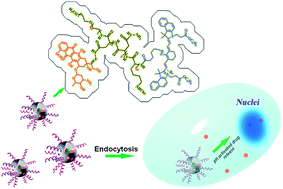Synthesis of polypeptide conjugated with near infrared fluorescence probe and doxorubicin for pH-responsive and image-guided drug delivery†
Abstract
A near infrared fluorescent polymeric drug delivery system (NIRF DDS) with pH-responsive drug release properties has been designed and developed. This material was prepared by chemical conjugation of the anticancer drug doxorubicin and hydrophobic aminocyanine dye to triblock copolypeptide via hydrazone and amide bonds, respectively. Conjugation with aminocyanine shows almost no toxicity of the material, while conjugation with doxorubicin induces pronounced toxicity on the original biocompatible material. The pH sensitive drug release nature of the near infrared fluorescent polymeric drug (NIRF prodrug) was confirmed by accelerated drug release at pH of 5.0 via an in vitro drug release experiment and gradual drug cleavage from the NIRF prodrug during a confocal laser scanning microscopic (CLSM) experiment. The CLSM experiment also reveals that the released drug subsequently migrated to the nucleus, while the polymeric residue still remained in cytoplasm, indicating that the as-prepared polymer can be a promising candidate for theranosis of cancer.


 Please wait while we load your content...
Please wait while we load your content...